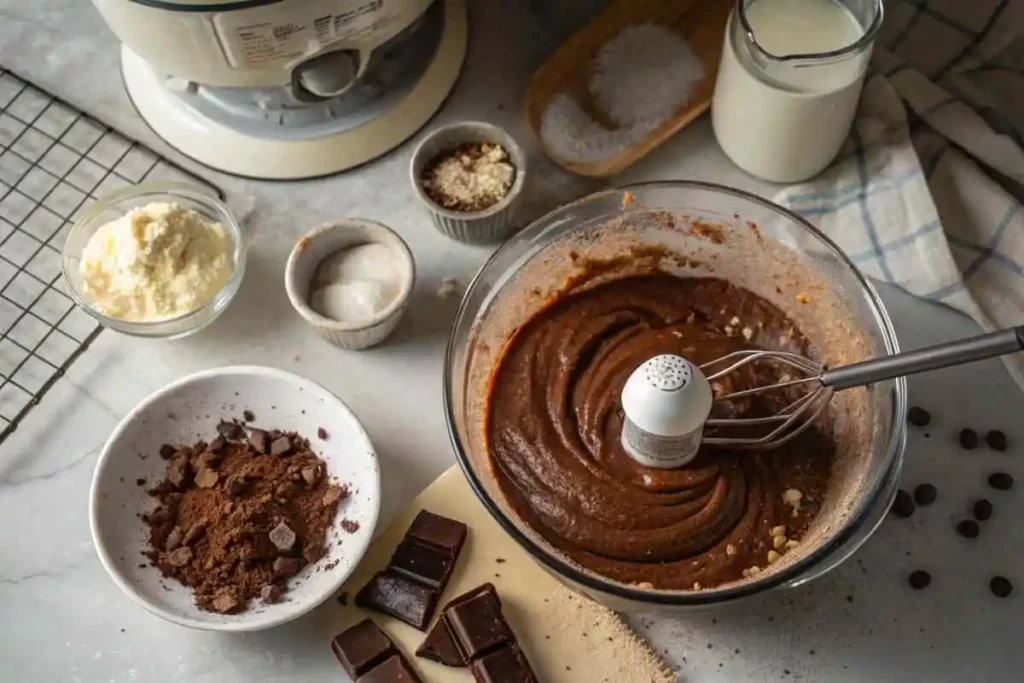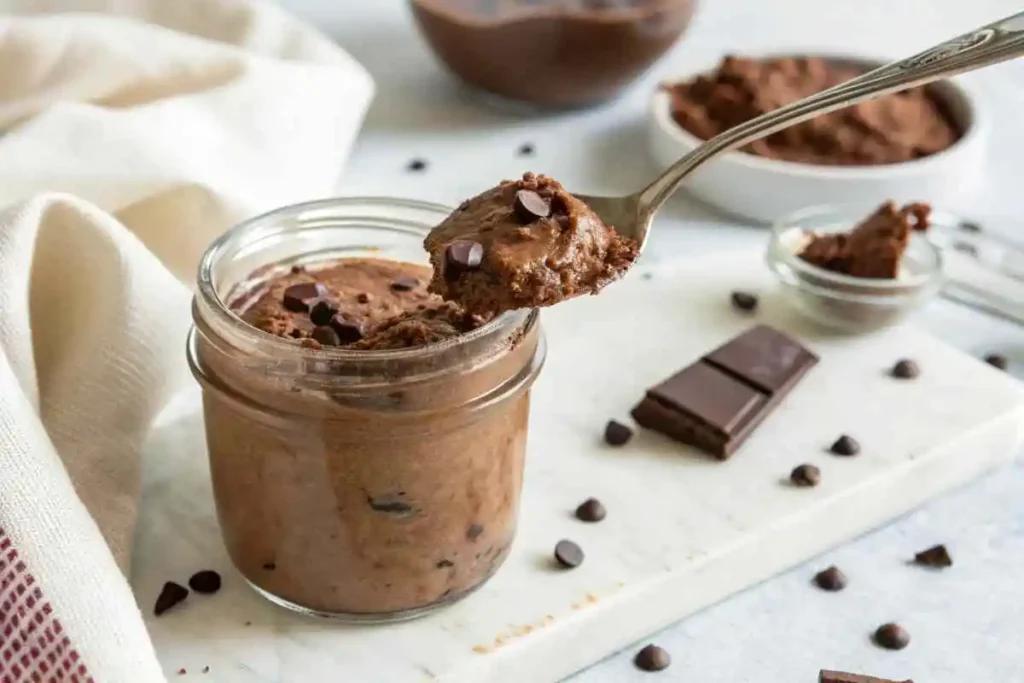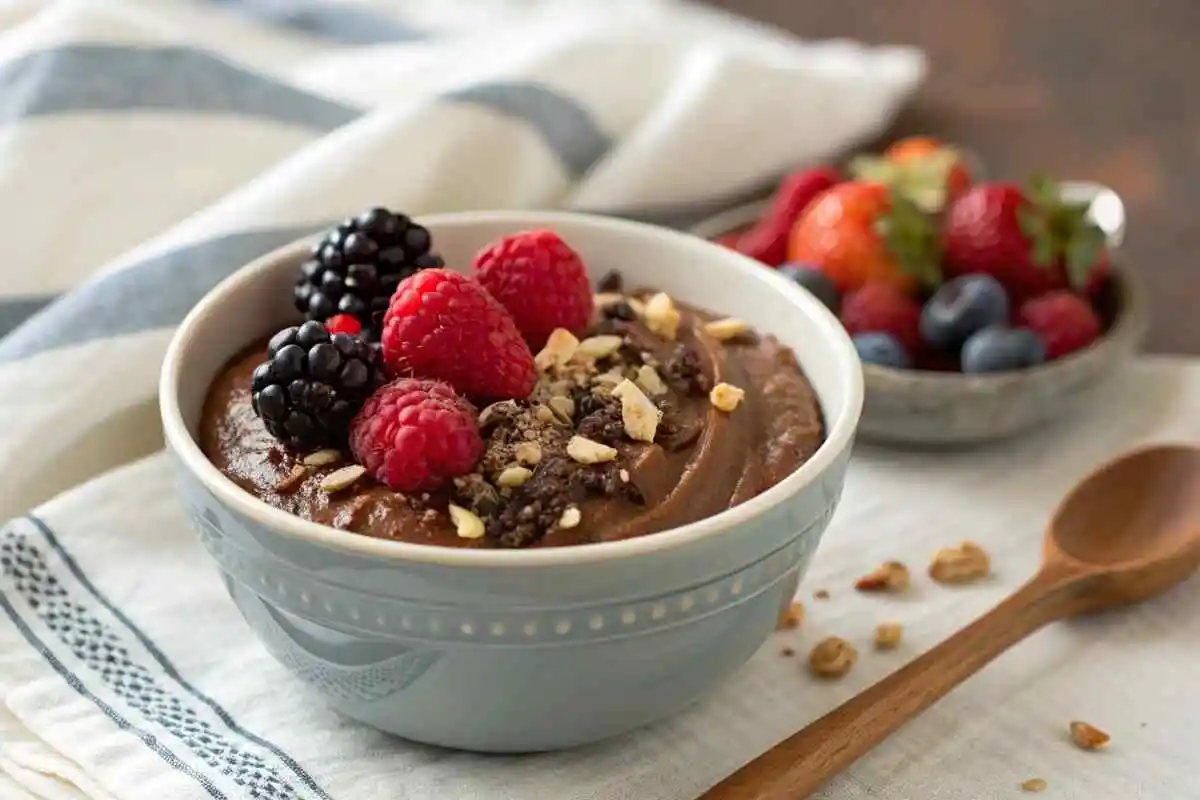Let’s explore the world of cottage cheese chocolate pudding! It might seem unconventional, but believe me – this dessert is a game changer. We’re reimagining a cherished childhood classic with a healthier, more delicious twist.
This isn’t your standard, sugar-laden pudding recipe. Instead, we’re utilizing the unique properties of cottage cheese to craft something truly special. It’s a wonderful way to indulge your sweet cravings without the guilt. For more delicious dessert ideas, check out our Breakfast & Dessert category!
We’ll guide you through everything you need to know, from the remarkable benefits of this surprisingly simple recipe to detailed, step-by-step instructions. You’ll be enjoying creamy, chocolatey perfection in no time. Prepare to find your new favorite dessert!
Why Cottage Cheese in Pudding?
But why cottage cheese, you ask? It’s an incredibly nutrient-rich ingredient! This often-overlooked component significantly boosts the protein content of your dessert. Plus, it delivers an exceptionally smooth and creamy texture without relying on heavy cream.
Controlling the sweetness is also straightforward, making this a fantastic option for reducing your sugar intake. It’s a truly beneficial choice! And, offering a subtly different texture, it’s a clever way to encourage even the pickiest of eaters – and treat ourselves, too.
What is Cottage Cheese Chocolate Pudding?
Let’s address the initial thought: cottage cheese in pudding? It certainly sounds different! However, the goal isn’t to taste the cottage cheese itself, but to create a rich, decadent chocolate treat with a beneficial, hidden ingredient. This cottage cheese chocolate pudding is carefully designed to replicate the smooth texture and satisfying flavor of traditional pudding, all while providing a substantial nutritional advantage.
This dessert is remarkably adaptable to various dietary preferences and requirements. We’re transforming a frequently underestimated dairy product into something utterly irresistible. Don’t let the name deter you – this is a genuinely delightful and satisfying experience.
Understanding the Texture
The primary concern many people have is, “Will I actually taste the cottage cheese?” The answer is a definitive no! When thoroughly blended, the cottage cheese disintegrates completely, yielding an unbelievably smooth and creamy mouthfeel. Consider it a natural thickener and creaminess enhancer.
The specific type of cottage cheese you choose will influence the final result. Full-fat cottage cheese contributes the richest texture, while low-fat options create a lighter consistency. Small-curd cottage cheese blends the most seamlessly, though larger curd varieties can also work with slightly more blending.
Nutritional Benefits
Let’s examine the nutritional profile. Traditional chocolate pudding often contains high levels of sugar and lacks essential nutrients. This cottage cheese chocolate pudding breaks that mold! A single serving provides a substantial amount of protein, thanks to the contribution of the cottage cheese. It’s also an excellent source of calcium, crucial for maintaining strong bones.
Compared to a standard chocolate pudding (typically around 150 calories and 20 grams of sugar), a serving of this version can be significantly lower in both calories and sugar, depending on your sweetener selection. You’re free to customize the sweetness level using honey, maple syrup, or sugar-free alternatives. It’s a delicious indulgence that allows you to prioritize your health and fitness goals – a truly guilt-free dessert the whole family can enjoy. For more information on nutrition, you can visit Healthline.
The Best Cottage Cheese Chocolate Pudding Recipe
This recipe is my go-to when I crave a quick, healthy dessert that everyone enjoys. My kids consistently request this cottage cheese chocolate pudding, and I’m certainly not complaining! It’s quick to prepare, requiring just a few simple ingredients, and delivers a decadent treat in minutes – plus chilling time, of course.
This version readily adapts to your personal preferences—adjust the sweetness, incorporate different flavors, or add extra textures to your liking. Let’s begin! If you’re looking for more recipes to round out your meals, explore our Lunch & Snack options.
Ingredients

Here’s what you’ll need:
- 16 ounces (2 cups) small-curd cottage cheese, full-fat or low-fat
- 1/2 cup unsweetened cocoa powder
- 1/4 – 1/2 cup sweetener (granulated sugar, honey, maple syrup, or stevia, to taste)
- 1 teaspoon vanilla extract
- 1/4 teaspoon salt (optional, but enhances flavor)
- 2 tablespoons chocolate chips (optional, for an extra chocolatey touch!)
Equipment Needed
You won’t require much specialized equipment! A blender or food processor is essential, along with measuring cups and spoons. And, of course, individual serving dishes or a larger bowl for family-style presentations.
Step-by-Step Instructions

- Combine Ingredients: Add the cottage cheese, cocoa powder, your preferred sweetener, vanilla extract, and salt (if using) to your blender or food processor.
- Blend: Begin blending on low speed, gradually increasing to high. This is where the transformation happens! Blend for several minutes, pausing occasionally to scrape down the sides as needed, until the mixture is perfectly smooth and creamy. Patience is key to eliminating any remaining cottage cheese texture – it may take 3-5 minutes, depending on your appliance.
- Taste and Adjust: Once smooth, sample the pudding. This is your opportunity to fine-tune the sweetness. Add more sweetener, one tablespoon at a time, until it reaches your desired flavor. If using chocolate chips, gently fold them in now.
- Pour into Dishes: Pour the pudding into individual ramekins, small bowls, or charming jars, or transfer it to a larger serving bowl.
- Chill: Cover the dishes with plastic wrap or lids and refrigerate for at least 2 hours, or ideally overnight. This allows the pudding to fully set and the flavors to meld beautifully, resulting in a thicker, more delicious dessert.
Recipe Notes
For the most intense chocolate flavor, utilize high-quality cocoa powder. Don’t hesitate to experiment with various sweeteners to find your personal favorite. If your pudding is too thick, introduce a tablespoon of milk (dairy or non-dairy) at a time until you achieve your desired consistency. Conversely, if it’s too thin, blend in a tablespoon of additional cottage cheese.
Blending is paramount! Achieving a flawlessly smooth pudding takes time and attention. If you’re using a food processor instead of a blender, you might need to blend for a longer duration and scrape down the sides more frequently. And remember, a touch of salt really elevates the chocolate flavor – don’t skip it! If you are interested in learning about different types of kitchen tools and techniques, explore our About Us page for more information.
Variations & Customizations

The remarkable aspect of this cottage cheese chocolate pudding recipe is its incredible adaptability. Once you’ve mastered the base recipe, the possibilities are virtually endless. Feel free to unleash your creativity and personalize it to your tastes and dietary demands. It’s a fantastic foundation for flavor exploration.
Don’t be afraid to venture beyond the basics and experiment with different additions and modifications. This recipe truly flourishes with personalization!
Chocolate Intensity
If you prefer a milder chocolate flavor, reduce the amount of cocoa powder to 1/3 cup. For a more intensely dark and decadent taste, increase it to 3/4 cup. The type of cocoa powder also influences the flavor profile: Dutch-processed cocoa provides a smoother, milder experience, while natural cocoa powder offers a bolder, more acidic taste reminiscent of classic chocolate.
Flavor Boosters
Take your pudding to the next level with a touch of something extra special. A few drops of peppermint extract create a refreshing chocolate-mint sensation. A teaspoon of almond extract adds a delicate, nutty aroma. For warmer notes, incorporate 1/2 teaspoon of cinnamon or a pinch of nutmeg. And for peanut butter enthusiasts? A swirl of approximately 1-2 tablespoons of peanut butter creates a truly sublime combination. You can also add a tablespoon of instant coffee granules for a mocha-inspired twist!
Dietary Adaptations
This recipe is easily adjusted to accommodate a range of dietary needs.
- Sugar-Free: Substitute traditional sugar with a sugar alternative such as stevia, erythritol, or monk fruit. Adjust the quantity to match your preferred level of sweetness, as these sweeteners vary in potency.
- Vegan: Plant-based cottage cheese alternatives are becoming increasingly available. If you can locate one, it’s an excellent substitute. However, please note that the texture may differ slightly – it could be less thick.
- Dairy-Free: Utilize a plant-based cottage cheese alternative and carefully verify that both your chosen sweetener and vanilla extract are also dairy-free. Many vanilla extracts contain glycerin derived from animal sources.
Frequently Asked Questions
I consistently receive a few key questions about this cottage cheese chocolate pudding. Here’s a compilation of frequently asked questions – hopefully, answering any lingering uncertainties.
Can you put chocolate in cottage cheese?
Absolutely! It may sound unusual, but chocolate and cottage cheese unexpectedly pair very well. When blended together, the cottage cheese yields an extraordinarily smooth and creamy base for the chocolate flavor to truly shine. You won’t detect any cottage cheese taste—just pure chocolate bliss! It’s a clever method for adding protein and creaminess without relying on heavy cream or excessive sugar.
How to eat cottage cheese for protein?
Beyond this delectable pudding, there are numerous ways to incorporate more cottage cheese into your diet for a protein boost. Enjoy it with fresh fruit and a drizzle of honey for breakfast or a light snack. Blend it into your morning smoothie for enhanced thickness and nutritional value. Alternatively, savor it as a savory snack with chopped vegetables and everything bagel seasoning for a satisfying and healthy bite.
How do you make sugar free pudding with cottage cheese?
Creating a sugar-free version of this pudding is remarkably simple! Simply replace the granulated sugar, honey, or maple syrup with your preferred sugar substitute. Stevia, erythritol, and monk fruit are all excellent choices. Remember to start with a modest amount and adjust to accomplish your ideal level of sweetness, as these substitutes vary.
How long does pudding take to set?
Patience is key to achieving the perfect consistency. The pudding requires at least 2 hours of refrigeration to fully set and develop its proper pudding-like texture. However, for the absolute best outcome, I recommend chilling it overnight. This allows the flavors to meld harmoniously and the texture to become impeccably firm. It will continue to firm up as it chills, so don’t worry if it appears slightly wobbly initially.
Serving & Storage
Now for the enjoyable part—savoring your homemade cottage cheese chocolate pudding! Serving is straightforward, but these final touches can truly enhance the experience.
For a truly luxurious treat, top each serving with a dollop of whipped cream (dairy or non-dairy, as you prefer!). A sprinkle of chocolate shavings, a handful of fresh berries, or a crunchy sprinkle of granola adds a delightful texture and visual appeal. A tiny pinch of sea salt on top can beautifully accentuate the chocolate flavor. We’re always looking for feedback, so feel free to contact us with your thoughts!
To store any leftovers, cover the pudding tightly with plastic wrap or transfer it to an airtight container. It will maintain its quality in the refrigerator for up to 3-5 days. Be aware that the texture may slightly separate over time, but a quick stir will swiftly restore its creamy consistency. While it’s best enjoyed fresh, it’s still delectable several days later – that is, if it lasts that long!

